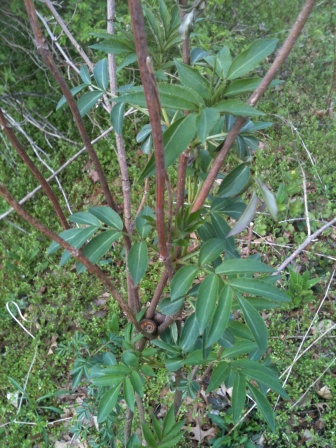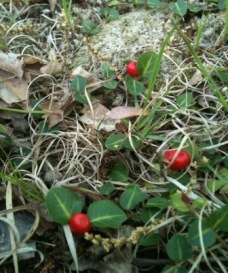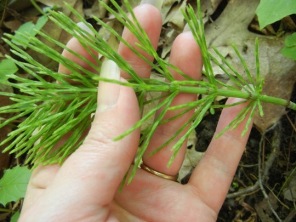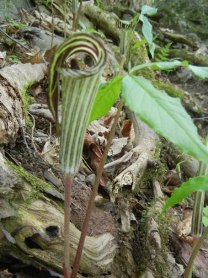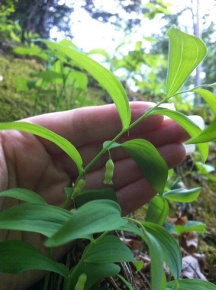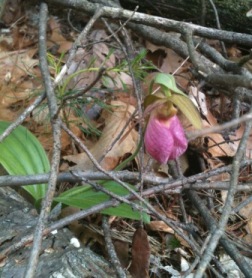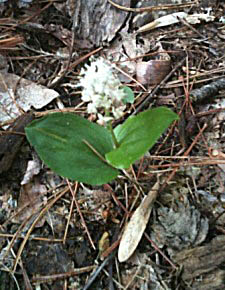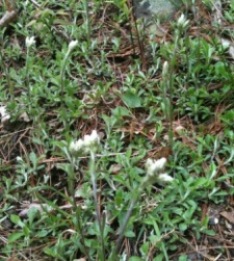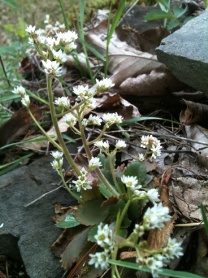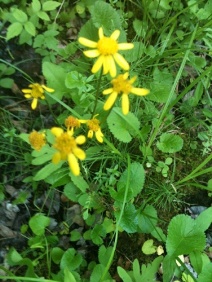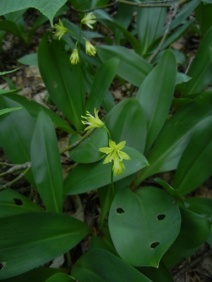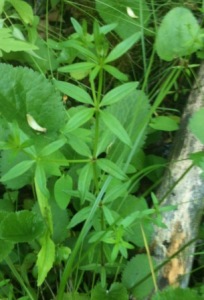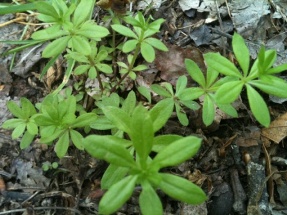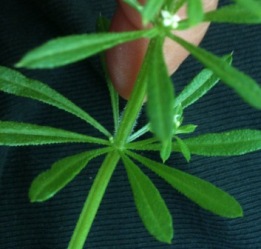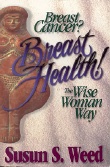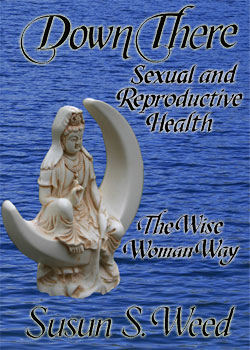The Green Report
May 22, 2012
The Green Report: Back to the Forest
Elder (Sambucus canadensis)
Elder is a mysterious, medicinal, and magical tree said to be inhabited by a spirit, often called “Elda Mohr,” or “Frau Hollender,” who takes revenge on those who do not respect the elder. To cut or burn elder is thought to be such bad luck that a major road works in England was redesigned when the workers refused to destroy a lush stand of elder. Elder berries are anti-viral. The flowers counter fevers. We will make elder remedies later in the year. Elder does just as well in your garden or by the road as it does in the woods.
Partridge berry (Mitchella repens)
This creeping plant has a reputation as a medicine plant but is rarely used. I wrote a monograph on it in The United Plant Savers book Saving the Future. The red berries are perfectly safe to eat, though tasteless. Partridge berry is often confused with wintergreen, as they are both small plants with large red berries. The smell is the real identifying mark, which you have to experience in person. Protect this plant.
Horsetail (Equisetum arvense)
Horsetail is one of the few non-flowering, non-mushroom plants commonly used by herbalists. My teachers were insistent that it be picked before the end of May, so get out and get it if you are planning to use it this year. Apparently, the silica content gets higher and higher as the plant grows, making the older plants problematic for the kidneys. A pinch of horsetail added to other infusions is said to make the minerals even more active and absorbable.
Jack/Jill in the pulpit (Ariseama atrorubens)
AKA Indian turnip, Dragonroot
There really are both Jacks and Jills in the spathe of this flower. Lift the lid carefully and see for yourself. All parts of the fresh plant are horribly irritating to the mucus surfaces of the digestive system, so this is considered a poisonous plant, though native people did use it for both food and medicine. Milk is the antidote should you decide to try it yourself. Protect this plant.
Solomon’s seal (Polygonatum biflorum)
This is another plant now considered poisonous that native people used medicinally, though mostly externally. All varities (such as P. multiflorum) are considered interchangeable. A European variety (P. odoratum), which contains a constituent that lowers blood sugar, is still in regular use, especially in China. Protect this plant.
Lady’s slipper orchid (Cypripedium pubescens)
AKA Moccasin flower
Protect this plant. The root of this prized orchid was formerly used is women’s tonics to counter hysteria and headaches. Like most perennials of the forest, it is now in danger and modern herbalists use other plants (such as motherwort) to help women who are anxious and nervous. Protect this plant.
Wild Lily of the Valley (Maianthemum canadense)
AKA Canada Mayflower
Garden varieties of lily of the valley contain glycosides that disrupt heartbeat. I have found no references to the use of wild lily of the valley, so I merely enjoy the fragrance and its delicate beauty. For every hundred leaves I find, there is but one flower. Protect this plant.
Solitary Pussy toes (Antennaria solitaria)
Several varieties of pussy toes grace open areas of the woodlands of the Northeast. The flowers are very persistent and tickle my fancy (as well as my chin when I lean down), but I know of no edible or medicinal uses of this delightful plant.Saxifrage (Saxifraga virginiensis)
“Saxe” means “rock,” and “frage” means “to break” or “to fragment,” a reminder of the fanciful idea that this plant can literally break the rocks it grows in. I have never been tempted to eat or use this little wildflower. I enjoy the beauty of the flowers best by lying on my belly. Protect this plant.
Liferoot (Senecio aureus)
Although considered poisonous by many authors, I have found the tincture of the fresh aerial parts (flowers, stalks, and lyre-shaped leaves, plus a few basal leaves) of liferoot to be one of the very best remedies for women with extremely painful menses. Doses of 5-10 drops, taken daily between the last days of the flow and ovulation, are generally successful after 4-5 months. More in New Menopausal Years the Wise Woman Way.Trout lily (Erythronium americana) AKA Adder’s tongue
The mottling of the leaves resembles the pattern on a trout, thus the name. Although lilies whose flowers point down or to the side are generally poisonous, the little trout lily leaves may be eaten, with caution. Like wild lily of the valley, there are hundreds of plants growing on the floor of my woods, but few that actually bloom. Protect this plant.
Wild licorice (Galium circaezans)
Leaves in 4’s
Fragrant bedstraw (Galium triflorum)
Leaves in 6’s
Cleavers (Galium aparine) AKA Goosegrass
Leaves in 8’s
The bedstraw family includes many useful members, all of which contain a blood-thinning compound (coumarin) remarkably similar to the drug coumadin. Not just these three, but also woodruff, wild madder, and others. I enjoy them as a snack while rambling in the woods, cherishing their individual tastes. And I put the tender growing tips in salads. Woodruff (a cultivated plant) is the classic herb in May wine, but fragrant bedstraw is a wild substitute. Cleavers is the big medicine in this family.
From the Wise Woman Herbal Ezine
For permission to reprint this article, contact us at: susunweed@herbshealing.comSusun Weed - PO Box 64, Woodstock, NY 12498 (fax) 1-845-246-8081
Visit Susun Weed at: www.susunweed.com and wisewomanbookshop.com
Wise Woman Herbal for the Childbearing Year
Author: Susun S. Weed. Simple, safe remedies for pregnancy, childbirth, lactation, and newborns. Includes herbs for fertility and birth control. Foreword by Jeannine Parvati Baker. 196 pages, index, illustrations.
Retails for $14.95
Order at: www.wisewomanbookshop.com
Healing Wise
Author: Susun S. Weed. Superb herbal in the feminine-intuitive mode. Complete instructions for using common plants for food, beauty, medicine, and longevity. Introduction by Jean Houston. 312 pages, index, illustrations. Retails for $21.95
Order at: www.wisewomanbookshop.com

NEW Menopausal Years the Wise Woman Way
Author: Susun S. Weed. The best book on menopause is now better. Completely revised with 100 new pages. All the remedies women know and trust plus hundreds of new ones. New sections on thyroid health, fibromyalgia, hairy problems, male menopause, and herbs for women taking hormones. Recommended by Susan Love MD and Christiane Northrup MD. Introduction by Juliette de Bairacli Levy. 304 pages, index, illustrations. Retails for $19.95
Order at: www.wisewomanbookshop.com
For excerpts visit: www.menopause-metamorphosis.com
Breast Cancer? Breast Health!
Author: Susun S. Weed. Foods, exercises, and attitudes to keep your breasts healthy. Supportive complimentary medicines to ease side-effects of surgery, radiation, chemotherapy, or tamoxifen. Foreword by Christiane Northrup, M.D. 380 pages, index, illustrations. Retails for $21.95
Order at: www.wisewomanbookshop.com
Down There: Sexual and Reproductive Health the Wise Woman Way
Publication date: June 21, 2011
Author: Susun S. Weed Simple, successful, strategies cover the entire range of options -- from mainstream to radical -- to help you choose the best, and the safest, ways to optimize sexual and reproductive health. Foreword: Aviva Romm, MD, midwife, 484 pages, Index, illustrations. Retails for $29.95
Order at: www.wisewomanbookshop.com
For Wholesale orders see our terms letter or contact us at:
Ash Tree Publishing PO Box 64 Woodstock, NY 12498 ~ Phone/Fax: 1-845-246-8081
Website: wisewomanbookshop.com ~ E-mail: susunweed@herbshealing.com
Susun Weed, green witch and wise woman, is an extraordinary teacher with a joyous spirit, a powerful presence, and an encyclopedic knowledge of herbs and health. She is the voice of the Wise Woman Way, where common weeds, simple ceremony, and compassionate listening support and nourish health/wholeness/holiness. She has opened hearts to the magic and medicine of the green nations for three decades. Ms. Weed's four herbal medicine books focus on women's health topics including: menopause, childbearing, and breast health. Visit her site www.susunweed.com for information on her workshops, apprenticeships, correspondence courses and more! Browse the publishing site online at wisewomanbookshop.com to learn more about her alternative health books. Venture into the NEW Menopause site www.menopause-metamorphosis.com to learn all about the Menopausal Years the Wise Woman Way.
back to articles index
back to press kit
© Susun Weed -Wise Woman Center
~ Disclaimer & Privacy Policy ~
